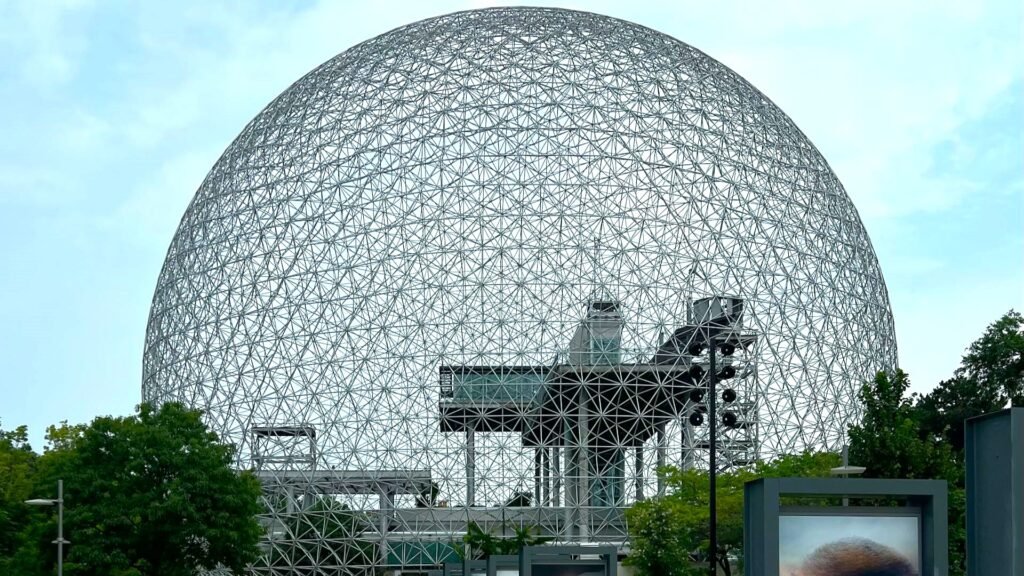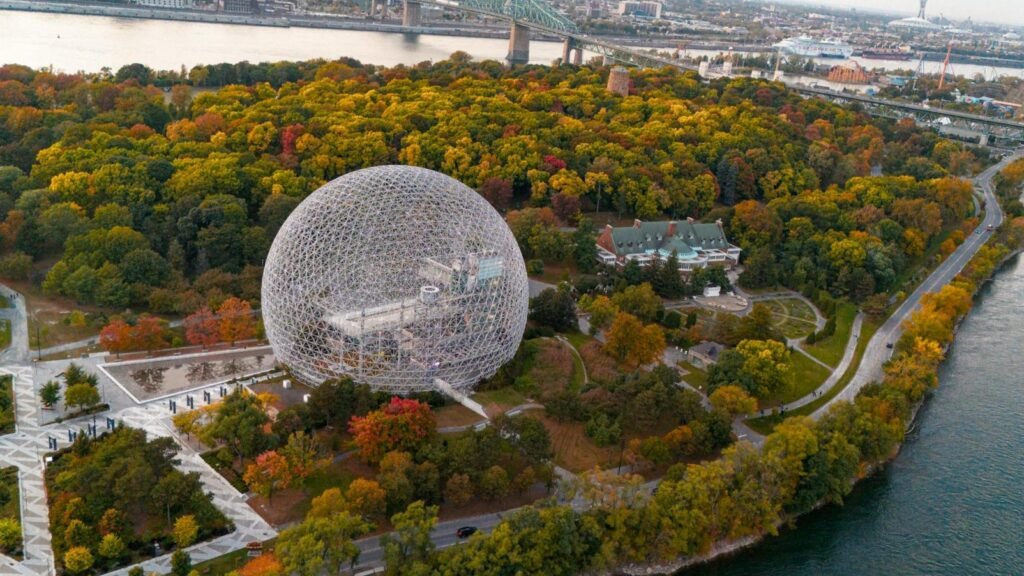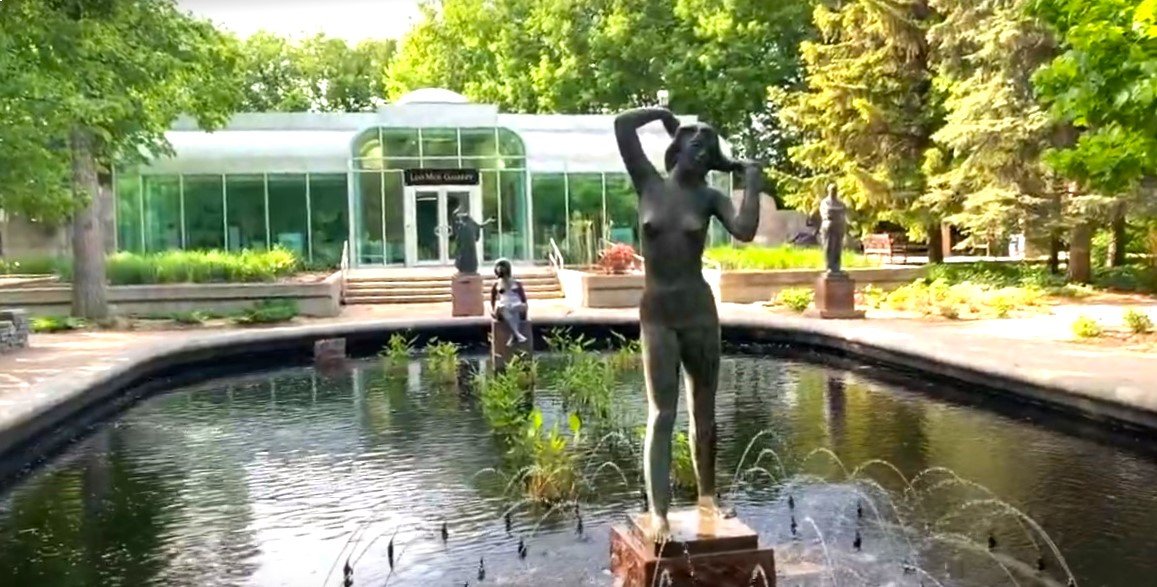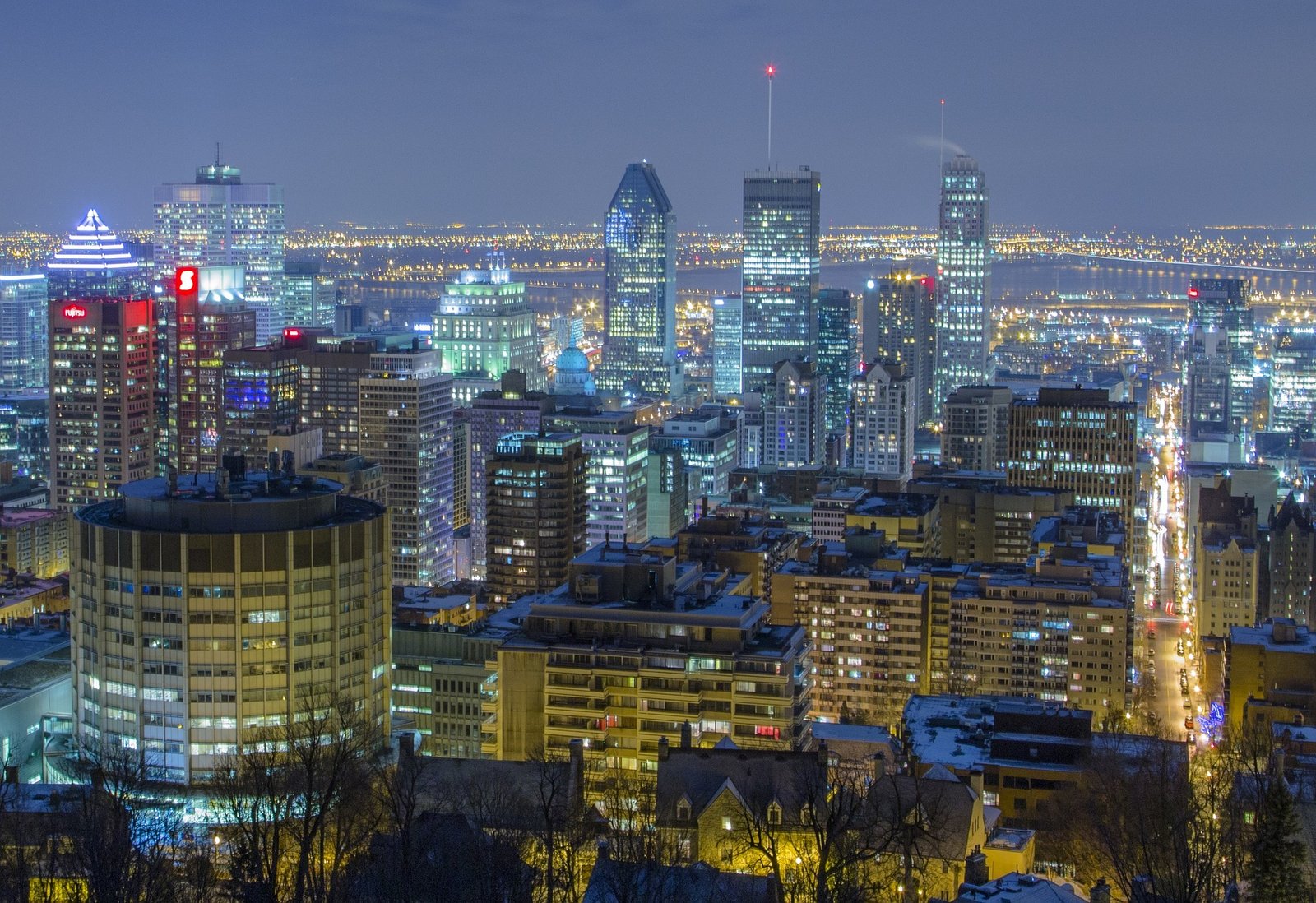The Montreal Biosphere Environment Museum is more than just a stunning architectural landmark; it stands as a powerful symbol of environmental awareness and education. Located on Île Sainte-Hélène within the beautiful Parc Jean-Drapeau, this unique museum has become an icon of Montreal’s dedication to sustainability and environmental stewardship. Originally constructed as the United States pavilion for Expo 67, the Biosphere remains one of the city’s most recognizable and visited structures.
Each year, the Montreal Biosphere Environment Museum draws visitors from across the globe, eager to explore its engaging exhibits and learn about the critical environmental issues facing our planet. A visit to the Montreal Biosphere Environment Museum offers a chance to connect with these important topics in a compelling and inspiring setting.
The Architecture:
The Biosphere’s design is a masterpiece by visionary architect Buckminster Fuller. The geodesic dome, composed of a complex lattice of steel and acrylic, covers an area of over 18,000 square meters. It is an impressive example of lightweight, yet strong, structural engineering that maximizes space while minimizing material use. This innovative design aligns with the Biosphere’s mission of promoting sustainable practices.
After a fire in 1976 destroyed the acrylic covering, the structure was left as an open-air dome until it was repurposed as an environment museum in 1995. The now-open steel framework, with its striking geometric patterns, stands as a testament to resilience and adaptation, mirroring the themes of environmental sustainability that the museum champions.
Permanent Exhibits:
The Montreal Biosphere houses several permanent exhibits that delve into various environmental themes. These exhibits are interactive, allowing visitors to engage directly with the content:
Ecolab: This exhibit focuses on the science of ecosystems, offering insights into how different species interact within their habitats. Visitors can explore the balance of ecosystems and the impact of human activities on biodiversity.
Climate Change: An in-depth look at the causes and effects of climate change, this exhibit features interactive displays that explain global warming, the greenhouse effect, and the role of human activity in accelerating these processes. It also highlights the importance of individual and collective action to mitigate climate impacts.
Water: A Resource Under Pressure: Water conservation and the challenges surrounding this vital resource are central themes of this exhibit. Visitors learn about the global water crisis, the importance of wetlands, and the impact of pollution on freshwater ecosystems.
Urban Ecosystems: This exhibit explores the relationship between urban development and the natural environment. It examines how cities can be designed or modified to be more sustainable and highlights innovative urban planning practices from around the world.
Temporary Exhibits and Events:
In addition to its permanent exhibits, the Montreal Biosphere regularly hosts temporary exhibits that focus on current environmental issues. These exhibits often feature cutting-edge research, art installations, and multimedia presentations that challenge visitors to think critically about the world around them.
The museum also organizes events such as workshops, lectures, and film screenings, providing a platform for environmental experts, activists, and artists to share their work with the public. These events are designed to inspire dialogue and action on a wide range of environmental topics.
Educational Programs:
The Biosphere is deeply committed to education, offering a variety of programs for schools, families, and the general public. These programs include:
Guided Tours: Knowledgeable guides lead visitors through the museum, providing in-depth explanations of the exhibits and answering questions. These tours are available in both English and French and can be tailored to different age groups and interests.
Workshops: Hands-on workshops allow participants to engage with environmental topics in a practical way. Activities may include building models, conducting experiments, or creating art from recycled materials.
School Programs: The Biosphere offers specialized programs for school groups that align with the Quebec education curriculum. These programs include guided tours, workshops, and educational materials that teachers can use to extend learning beyond the museum visit.

Sustainable Practices:
The Biosphere itself is a model of sustainable design. The building is equipped with various eco-friendly features, including:
The Montreal Biosphere isn’t just a place to learn about sustainability; it’s a living, breathing example of it. The building itself is a model of eco-conscious design, incorporating a range of innovative features that minimize its environmental impact :
Energy Efficiency:
Take energy efficiency, for example. The Biosphere utilizes state-of-the-art, energy-efficient lighting and heating systems, significantly reducing its energy consumption. And to further lessen its carbon footprint, solar panels have been integrated into the building’s design, harnessing the power of the sun to generate clean energy.
Water Conservation:
Water conservation is another key element of the Biosphere’s sustainable practices. Rainwater is carefully collected and then used for irrigation in the museum’s surrounding gardens, minimizing water waste. Inside the building, water-saving fixtures have been installed throughout, further reducing water usage.
Green Roof:
Perhaps one of the most visible examples of the Biosphere’s commitment to sustainability is its stunning green roof. This living roof not only provides valuable insulation for the building, helping to regulate its temperature, but it also plays a crucial role in reducing stormwater runoff, preventing erosion and flooding. Moreover, the green roof provides a vital habitat for local biodiversity, supporting a variety of plant and animal species and demonstrating how even urban spaces can be designed to promote ecological balance.
Visiting Experience:
A visit to the Montreal Biosphere is more than just a trip to a museum; it’s an immersive and thought-provoking experience. As you explore the exhibits, you’re not just passively observing; you’re actively invited to reflect on your own connection to the environment and to consider the ways, both big and small, that you can contribute to a more sustainable future. The Biosphere isn’t just about learning; it’s about inspiring action. And the experience extends beyond the exhibits themselves. The museum’s thoughtfully designed observation platforms offer breathtaking panoramic views of Montreal and the surrounding landscape, providing a powerful visual reminder of the interconnectedness between urban life and the natural world. It’s a chance to see the city in a new light, to appreciate its place within the broader ecosystem.
The Biosphere’s location within the beautiful Parc Jean-Drapeau further enhances the visiting experience, making it an ideal destination for a full day of exploration and recreation. After immersing yourself in the world of environmental science at the museum, you can step outside and enjoy a relaxing picnic amidst the park’s green spaces. Île Sainte-Hélène itself offers a wealth of other attractions to discover, from gardens and art installations to historical sites. Or perhaps you’d prefer a leisurely stroll along the waterfront, taking in the fresh air and enjoying the scenic views of the St. Lawrence River. A visit to the Montreal Biosphere isn’t just a single experience; it’s a gateway to a day filled with discovery, relaxation, and a renewed appreciation for the natural world.
Practical Information:
Location: 160 Chemin du Tour de l’Isle, Parc Jean-Drapeau, Montreal, Quebec, H3C 4G8, Canada.
Transportation: The museum is easily accessible by metro, with the Jean-Drapeau station just a short walk away. You can also reach the Biosphere by bike or car, with ample parking available on-site.
Admission Fees: Admission fees apply, with discounts for students, seniors, and families. Children under a certain age may enter for free. Special rates are often available for groups.
Hours of Operation: The Biosphere is open year-round, though hours may vary depending on the season. It’s best to check the official website for the latest information on opening hours, ticket prices, and any special events.
Dining Options: While the Biosphere doesn’t have a full-service restaurant, there are picnic areas nearby where visitors can enjoy packed lunches. During the warmer months, food trucks and cafés in Parc Jean-Drapeau offer a variety of snacks and meals.
Why Visit:
Why should you add the Montreal Biosphere to your must-see list? Simply put, it’s an experience that offers something for everyone. If you’re fascinated by environmental science, the Biosphere is a treasure trove of information, presented in engaging and interactive ways. Interested in sustainable living? You’ll find inspiration and practical ideas throughout the exhibits, demonstrating how we can all make a difference. And even if you’re simply drawn to unique and striking modern architecture, the Biosphere’s iconic design is worth the visit alone. But it’s more than just a beautiful building; it’s a place for thought-provoking exploration, offering insights into the critical challenges facing our planet and, more importantly, inspiring action towards a more sustainable future. Whether you’re a Montreal local looking for an enriching day out or a tourist eager to discover the city’s unique attractions, the Biosphere provides valuable perspectives and a renewed sense of purpose. It’s an experience that resonates with visitors of all ages, leaving a lasting impression and a sense of hope for a greener tomorrow.
Personal Experience:
My visit to the Montreal Biosphere was both educational and inspiring. The striking geodesic dome immediately draws you in, but it’s the content inside that leaves a lasting impression. The exhibits are engaging and well-curated, making complex environmental issues accessible to all visitors. I was particularly moved by the interactive elements, which allowed me to see firsthand the impact of climate change and other environmental challenges. The observation decks offered stunning views of the city, serving as a beautiful reminder of the connection between our urban environments and the natural world. Overall, it was a deeply rewarding experience that left me more informed and motivated to make a positive impact on the planet.



